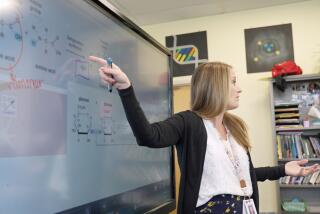Adult Literacy Heads Class in Welfare-to-Work Reform
CANTON, Ohio — After three years of adult-literacy classes, Mary Bowman still labors to read a newspaper or understand a form letter. She puzzles over sale prices because doing fractions in her head remains difficult. She and her teachers are resigned to the fact that Bowman will never pass the test for a high school equivalency certificate.
Yet by the evolving standards of adult educators across the nation, Mary Bowman is a success story.
The 40-year-old Bowman, who left school in the eighth grade to care for a little brother, helps her four young children with their homework. She looks you in the eye when she talks to you. She negotiates a bus system to get to work every day. And she juggles her children’s school schedules with her full-time job as a maintenance worker in a nursing home.
In short, Bowman has dramatically improved her ability to function as a parent, worker and community member. And for that, the Canton City School system proudly graduated her in June from its widely hailed adult-literacy program, Canton’s Even Start.
These may seem like unexpectedly low standards for adult-literacy educators to embrace. But two words explain the shift: welfare reform.
Having nudged most of their most-employable (and better-educated) recipients into work since reforms were enacted two years ago, many states now face a welfare population with daunting roadblocks to employment, including low levels of literacy. In Wisconsin, a state that has posted steep declines in its welfare rolls, 83% of those still receiving public assistance do not have high school diplomas. In Ohio, about half lack them.
Here in Canton, those who run adult-literacy classes have retooled for the new era. In doing so, they have formed a unique partnership with the state’s welfare administrators.
The federal government spent $124 million in 1998 on an array of family literacy programs, all of them under the Even Start umbrella. Critics say that their effectiveness has not been tested. But Canton’s program has become a model for other communities. In a campaign next month to promote innovation in welfare reform, Vice President Al Gore plans to praise Canton’s program, which draws half its funds from the federal government and half from local sources.
Focus Changes to Finding Jobs
The idea of training workers to read instructions and balance checkbooks rather than enjoy the cerebral pleasures of Charles Dickens or appreciate the intricacies of higher math is attractive to employers. To compete in today’s economy, they insist on workers who have an ability to learn and adapt. So if jobs are to be found for the 3 million people still on welfare across the nation, educators have concluded that they must adjust their goals. And fast.
In Canton, educators had always been extremely proud of their family literacy program for adults. It might take as many as five years with some students. But with grit and persistence, Canton’s teachers dragged many of the city’s most educationally challenged to successful completion of their high school equivalency certificates.
“We had a peach of a program, an award-winning program,” said Jane Meyer of the Canton adult education program in place until the spring of 1997. “But in the scheme of welfare reform, we realized, it wasn’t going to work.” Teaching literacy to adults with fewer skills would require some outside-the-box thinking.
So working with the state’s Department of Human Services and local businesses, Canton school officials crafted a program designed to serve some of the welfare roll’s most difficult cases.
One key new element was to make “work experience” a part of the curriculum. Along with two hours a day of classroom learning, the adult student works four hours at his or her child’s school--as a teaching assistant, cafeteria worker, janitor or office clerk. This satisfies the state’s requirement that welfare recipients work at least 20 hours a week. But officials believe it also promotes family literacy.
Keeping Children in the Equation
Mothers--most recipients are women--walk or ride the bus to school with their children and spend part of the day there. Officials believe that recipients gain self-confidence working with teachers and school administrators. And, as their academic skills increase, they are more likely to read and do homework with their children, boosting the children’s academic performance.
To drive home these indirect benefits, Canton’s Even Start teachers consistently address family matters in the classroom. Adult students keep detailed family journals, including a log of books that they have read with their children. During class time, home visits and scheduled parent-and-child play sessions, specially trained teachers offer their adult students a steady stream of parenting and homemaking advice.
“Many of our students are second- and third-generation welfare recipients,” said Even Start coordinator Meyer. “What we wanted to do was break the cycle of welfare dependency, first with them and then with their children. . . . And the last thing we needed was to do things that pull these moms away from their families for more time than we had to.”
Critics have questioned whether programs that aim to affect the academic performance of parents and children at the same time are effective at either goal. Some scholars of federal education efforts, like the University of Michigan’s Maris A. Vinovskis, have complained that Even Start programs have not been subject to rigorous outside review.
In programs like Canton’s Even Start, however, the task of measuring effectiveness is complicated. What, in an era of welfare reform, constitutes success or failure? Since the new program was inaugurated, 29% of participating parents have passed the General Equivalency Development test and 21% either secured a job for the first time or got a better one. It will take years to know whether the children of students like Bowman performed better in school because of their mother’s participation. In the meantime, she has something to brag about.
Practical Lessons for Every Day
On a recent day, Even Start teacher Michelle Miller deftly coaxed a classroom of 12 welfare mothers through a lesson in time management.
Miller opened by inviting students to name the major activities--sleep, child care, housekeeping, school and free time--that fill 86,400 seconds of each day (though it took some prompting before students remembered time spent in school and at work). She urged students to think of time as a resource that can be wasted or used productively every day. Then Miller asked the women to estimate how they spend a routine 24-hour period and write it down.
In the back-and-forth banter that ensued, Miller and her students discussed the pros and cons of time spent in front of the television, pondered the stresses in their lives and looked ahead at how a job would complicate the picture. Then, using long division and geometry, they calculated their activities as fractions of 24 hours and made pie charts of their typical days.
In coming weeks and months, students will return to the lesson, writing in journals and contemplating ways to streamline their lives, make time for their children and incorporate their jobs into the picture. In the process, teachers hope, they will learn valuable lessons not only in math and literacy but also in planning their time around competing demands.
In addition, students will work together on group projects that involve planning, budgeting, teamwork and follow-through. The projects range from organizing a special “math night” for their children’s school to making curtains for a sun-drenched classroom. While the team projects provide welcome services for their children’s school, the adult students gain something more: a rare opportunity to develop workplace skills.
When Even Start graduates like Bowman go to a prospective employer, lessons like these form an important part of the job pitch. On the strength of lessons like Miller’s time management exercise, Bowman could advertise to a prospective employer her ability to “organize time and resources to be punctual and maintain consistent attendance.” That, and many other “soft skills” that Canton’s program teaches, go into a “career passport,” a resume of sorts, prepared by students on a computer and tucked neatly into a bound packet with references, awards and letters from Even Start teachers.
To her enduring sadness, Bowman never could pass the test to get her high school equivalency certificate. “I wanted to get my GED,” she said at her home recently. “It was a big disappointment when I realized last year I couldn’t. . . . Working became my goal, but what I wanted was my GED.”
But in the eyes of some employers, Bowman’s career passport holds something of almost greater luster: Tucked in the folder’s back pocket is an award for outstanding attendance.
Bowman gives her children, who dragged her to school when her will flagged, some of the credit. But she cannot stifle her pride in her achievement and says that it was the key to landing the job she has now held for three months.
Today, Bowman still relies on a small welfare check to supplement a full-time job that pays $7.20 an hour. And she worries about the day that that small measure of help will end. But when asked what her future holds, she clutches a framed photograph of herself at summer’s Even Start graduation in a new blue dress with certificate in hand.
Bowman has not passed a GED test. But as her photograph and her “career passport” prove, she has succeeded at something. And she’ll find a way to make it through, she said.
“It’ll be hard. But I’ll still be working.”
More to Read
Sign up for Essential California
The most important California stories and recommendations in your inbox every morning.
You may occasionally receive promotional content from the Los Angeles Times.











